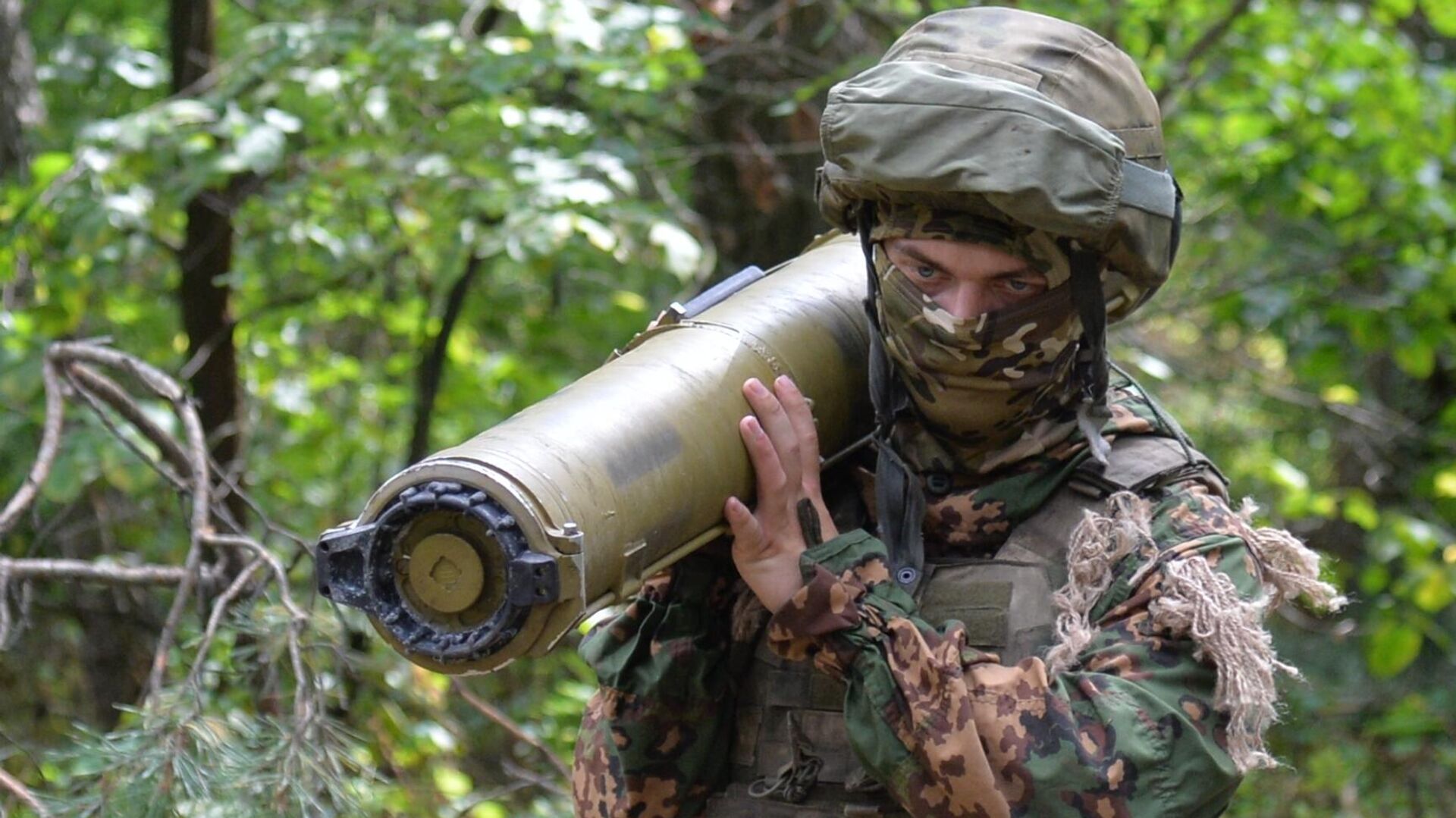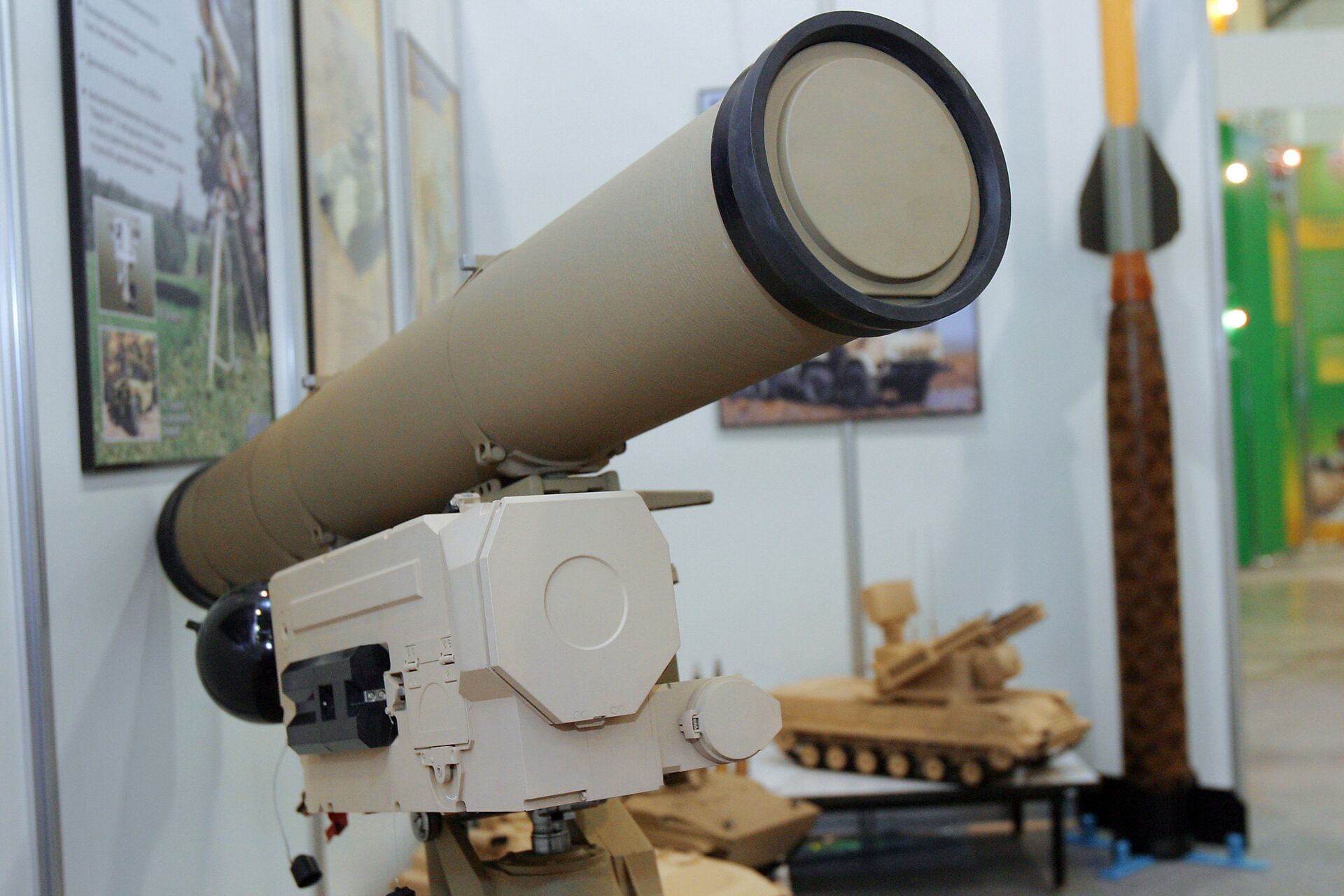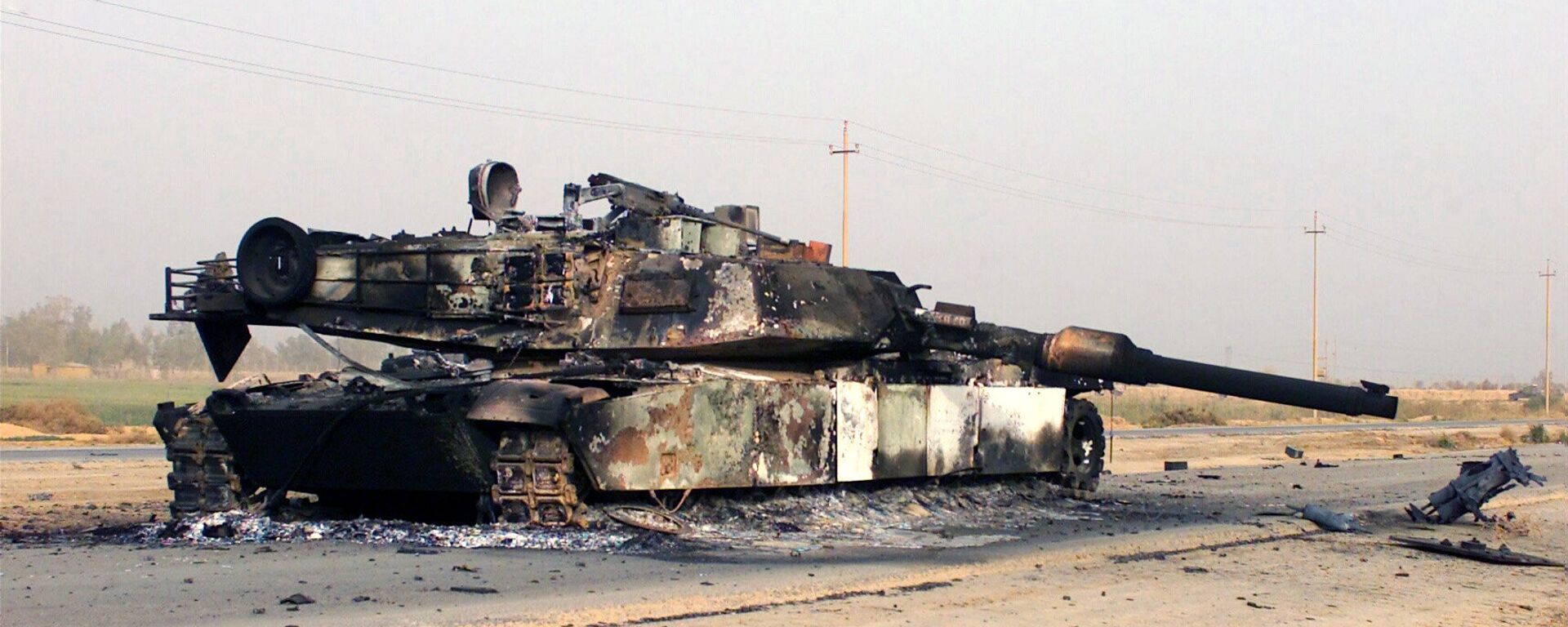https://sputnikglobe.com/20230411/kornet-most-fearsome-weapon-of-russias-tank-hunters-1109361417.html
Kornet: Most Fearsome Weapon of Russia’s Tank Hunters
Kornet: Most Fearsome Weapon of Russia’s Tank Hunters
Sputnik International
The Russian military is training special ‘tank hunter’ units designed to take on the German, British and American armor being sent to Ukraine. What sorts of weapons will Russian forces have at their disposal to counter the sophisticated Western heavy weapons platforms? Sputnik explores.
2023-04-11T14:57+0000
2023-04-11T14:57+0000
2023-04-16T19:52+0000
military
kornet
tank
anti-tank guided missile
anti-tank missile systems
analysis
hunter
russia
ukraine
m1a2 abrams
https://cdn1.img.sputnikglobe.com/img/07e7/04/0b/1109360190_0:33:1733:1007_1920x0_80_0_0_e115f7ef4b4d9cc38ccbc2d66389ce95.jpg
The Russian military is taking proactive steps to prepare to engage Challenger 2, Leopard 2, Abrams, and even Leclerc tanks. Speaking to media on Sunday, Russian Armed Forces Combat Training Center head Yevgeny Arifulin said troops have studied NATO tanks’ strengths and weaknesses, and absorbed a series of “methodological recommendations” created by Colonel General Ivan Buvaltsev, a veteran tankman with nearly 45 years of experience operating and commanding armored forces under his belt.German and NATO officials began confirming last month that the first batches of the nearly 300 Leopard 2, Challenger 2, and Abrams tanks promised to Kiev had begun trickling into the country.The UK’s decision to equip its Ukraine-bound Challengers with toxic depleted uranium munitions has sparked controversy, with scientists and activists expressing concerns that the conflict zone could be turned into a radioactive wasteland – just like parts of the former Yugoslavia and Iraq after their bombardment by NATO, US, and British forces in the 1990s and 2000s. NATO has ignored these concerns, while the UK’s MoD has assured that the DU rounds are safe, notwithstanding mountains of evidence to the contrary.“Britain has delivered the Challenger. Many NATO allies have delivered the Leopard 2, and the United States is now in the process of arranging deliveries of the Abrams. And this is in addition to, for example, the Marder infantry fighting vehicles and the American Bradley infantry fighting vehicles. All this together will give the Ukrainians the necessary means to return their territories and further push back Russian forces," Stoltenberg said at a press briefing last week.Kiev says it now has nearly 60 NATO MBTs in its inventory, and expects more to be delivered in the coming weeks.What Kinds of Weapons Will Russia’s Tank Hunters Have at Their Disposal?Arifulin did not go into detail about the types of weapons Russia’s special tank-hunting units could use in their operations against Western main battle tanks. But there are a variety of options, starting with the 2A46 125 mm smoothbore cannon fitted aboard the Russian T-90, T-80, T-72, and T-64 tanks, which have the necessary power to penetrate NATO armor in tank-on-tank engagements, provided the right operational deployment and combat support.From the air, Western MBT armor can be engaged using the 9K121 Vikhr, an aircraft-mounted laser-guided anti-tank missile system fitted aboard Su-25T attack aircraft, Ka-50 and Ka-52 helicopters, as well as some warships and coastal patrol ships. Armor-mounted systems include the 9M120 Ataka – a late Soviet-era HEAT warhead ATGM which can be equipped aboard a wide array of armored fighting vehicles, as well as helicopters.What Makes the Kornet Special?Then there’s the Kornet. Developed through the 1980s and 1990s and first entering into service with the Russian military in 1998, the Kornet is a widely-produced man-portable anti-tank guided missile system designed specifically to take on the latest NATO third-generation battle tanks like the Leopard 2, Challenger 2, and Abrams.While all of the systems listed above will almost certainly be among the equipment used by Russian forces against NATO armor in the coming months (unless a peace deal can somehow be reached), the Kornet is the only one among them with confirmed kills of German and US tanks under its belt.During the course of Turkiye’s police actions in Syria in 2016 and 2018, Ankara deployed dozens of its Leopard 2A4 tanks in the country, engaging in combat against Kurdish militants and Daesh (ISIS)* fighters. Over the course of the operations, Turkiye lost a dozen or more Leopard 2s to roadside bombs, suicide car bombs, and Russian-made anti-tank weapons.In a 2017 report, German investigators concluded that six of ten Leopard 2s destroyed in fierce fighting in the city of al-Bab were killed using Kornet missiles operated by Daesh fighters. Although several Leopards had previously been lost by NATO forces in Afghanistan to roadside bombs in the 2000s, the Turkish military’s losses in Syria helped to lift the air of invincibility around Germany’s tanks against modern anti-tank weapons once and for all.Kornets demonstrated similar characteristics against the vaunted Abrams tank in Iraq. Shortly after the US invasion in 2003, Iraqi special forces provided US forces with the first inkling that the war wouldn’t be anything like the first Gulf War in 1991 (when the Iraqi Army failed to knock out a single Abrams). This time around, Iraqi Republican Guard units equipped with Kornet anti-tank missiles knocked out two Abrams and a Bradley in fighting in the south of the country. Over half-a-dozen more Abrams, these ones belonging to the Iraqi Army, were destroyed by Daesh in Iraq between 2014 and 2016 using captured Kornets.Hezbollah similarly used Kornets to effect in 2006, destroying up to four of Israel’s coveted Merkava tanks (which are often touted as superior to the Abrams) during the Lebanon War.Why Are Kornets so Deadly?The secret behind the Kornet’s deadliness lies in its special tandem warheads – which can penetrate homogenous steel armor 1,000-1,600 mm thick (the Leopard 2A4 and Abrams have a maximum front armor thickness of 800 and 700 mm thick, respectively). After contact with the enemy tank, the first warhead explodes, with the second then generating a jet of immense heat that burns through armor, reaches the crew compartment, kills everyone inside, and detonates ammunition stores (which causes the MBT’s turret to be literally blown off in some instances).The latest models of the weapon feature top attack capability similar to that of the American Javelin, as well as thermobaric and blast fragmentation warheads for use against targets besides tanks.Kornets have a range of between 100 and 8,000 meters, making them deadly in urban environments, but equally dangerous across open spaces and the rolling plains which make up much of the Donbass and Ukraine east of the Dnepr River.Along with use by troops, Kornets can be mounted aboard customized Tigr infantry mobility vehicles, with the system, known as Kornet-EM, featuring two retractable launchers carrying four Kornet missiles apiece, plus eight additional rounds. The vehicles’ payload makes them capable of destroying entire platoons of enemy tanks, although operation is potentially more dangerous given the vehicles’ size compared to individual troops. The systems can also be fitted aboard BMP-2 and MBD-2 armored vehicles.How Many Kornets Does Russia Have?Since the system’s introduction in the late 1990s, Kornets have been exported to over two dozen countries around the world. The system’s producers – Degtyaryov Plant and the Volskiy Mekhanicheskiy Zavod, do not provide updated statistics about the number of Kornets produced. However, according to a 2010 estimate, about 35,000 had been made and sold by the late 2000s.* A terrorist group outlawed in Russia and many other countries.
https://sputnikglobe.com/20230409/russian-military-creating-special-groups-to-destroy-western-tanks-in-ukraine-1109292909.html
https://sputnikglobe.com/20230403/germanys-rheinmetall-building-service--logistics-hub-in-romania-for-nato-weapons-used-in-ukraine-1109063142.html
russia
ukraine
Sputnik International
feedback@sputniknews.com
+74956456601
MIA „Rossiya Segodnya“
2023
News
en_EN
Sputnik International
feedback@sputniknews.com
+74956456601
MIA „Rossiya Segodnya“
Sputnik International
feedback@sputniknews.com
+74956456601
MIA „Rossiya Segodnya“
kornet, anti-tank missile, portable anti-tank missile, abrams, javelin, leopard, challenger, main battle tank, what kinds of anti-tank weapons does russia have, russian anti-tank weapons, russian weapons against nato tanks, why are kornets so deadly, how many kornets does russia have
kornet, anti-tank missile, portable anti-tank missile, abrams, javelin, leopard, challenger, main battle tank, what kinds of anti-tank weapons does russia have, russian anti-tank weapons, russian weapons against nato tanks, why are kornets so deadly, how many kornets does russia have
Kornet: Most Fearsome Weapon of Russia’s Tank Hunters
14:57 GMT 11.04.2023 (Updated: 19:52 GMT 16.04.2023) The Russian military is training special “tank hunter” units designed to take on the German, British, and American armor being sent to Ukraine. What sorts of weapons will Russian forces have at their disposal to counter the sophisticated Western heavy weapons platforms? Sputnik explores.
The Russian military is taking proactive steps to prepare to engage Challenger 2, Leopard 2, Abrams, and even Leclerc tanks. Speaking to media on Sunday, Russian Armed Forces Combat Training Center head Yevgeny Arifulin said troops have studied NATO tanks’ strengths and weaknesses, and absorbed a series of “methodological recommendations” created by Colonel General Ivan Buvaltsev, a veteran tankman with nearly 45 years of experience operating and commanding armored forces under his belt.
“These are groups that will be directly involved in hunting for these [Western tanks]. In addition, tankers are being prepared here for tank duels. But the main thing is the tank hunters, who will be waiting for them in the area where these tanks would not like to see us,” Arifulin said.
German and NATO officials began confirming last month that the first batches of the nearly 300 Leopard 2, Challenger 2, and Abrams tanks promised to Kiev had begun trickling into the country.
The UK’s decision to equip its Ukraine-bound Challengers with toxic depleted uranium munitions has sparked controversy, with scientists and activists expressing concerns that the conflict zone could be turned into a radioactive wasteland – just like parts of the former Yugoslavia and Iraq after their bombardment by NATO, US, and British forces in the 1990s and 2000s. NATO has ignored these concerns, while the UK’s MoD has assured that the DU rounds are safe, notwithstanding mountains of evidence to the contrary.
“Britain has delivered the Challenger. Many NATO allies have delivered the Leopard 2, and the United States is now in the process of arranging deliveries of the Abrams. And this is in addition to, for example, the Marder infantry fighting vehicles and the American Bradley infantry fighting vehicles. All this together will give the Ukrainians the necessary means to return their territories and further push back Russian forces," Stoltenberg said at a press briefing last week.
Kiev says it now has nearly 60 NATO MBTs in its inventory, and expects more to be delivered in the coming weeks.
What Kinds of Weapons Will Russia’s Tank Hunters Have at Their Disposal?
Arifulin did not go into detail about the types of weapons Russia’s special tank-hunting units could use in their operations against Western main battle tanks. But there are a variety of options, starting with the
2A46 125 mm smoothbore cannon fitted aboard the Russian T-90, T-80, T-72, and T-64 tanks, which have the necessary power to penetrate NATO armor in tank-on-tank engagements, provided the right operational deployment and combat support.
From the air, Western MBT armor can be engaged using the
9K121 Vikhr, an
aircraft-mounted laser-guided anti-tank missile system fitted aboard Su-25T attack aircraft, Ka-50 and Ka-52 helicopters, as well as some warships and coastal patrol ships. Armor-mounted systems include the
9M120 Ataka – a late Soviet-era HEAT warhead ATGM which can be equipped aboard a wide array of armored fighting vehicles, as well as helicopters.
What Makes the Kornet Special?
Then there’s the Kornet. Developed through the 1980s and 1990s and first entering into service with the Russian military in 1998, the
Kornet is a widely-produced man-portable anti-tank guided missile system
designed specifically to take on the latest NATO third-generation battle tanks like the Leopard 2, Challenger 2, and Abrams.
While all of the systems listed above will almost certainly be among the equipment used by Russian forces against NATO armor in the coming months (unless a peace deal can somehow be reached), the Kornet is the only one among them with confirmed kills of German and US tanks under its belt.
During the course of Turkiye’s police actions in Syria in 2016 and 2018, Ankara deployed dozens of its Leopard 2A4 tanks in the country, engaging in combat against Kurdish militants and Daesh (ISIS)* fighters. Over the course of the operations, Turkiye lost a dozen or more Leopard 2s to roadside bombs, suicide car bombs, and Russian-made anti-tank weapons.
In a 2017 report, German investigators concluded that six of ten Leopard 2s destroyed in fierce fighting in the city of al-Bab were killed using Kornet missiles operated by Daesh fighters. Although several Leopards had previously been lost by NATO forces in Afghanistan to roadside bombs in the 2000s, the Turkish military’s losses in Syria
helped to lift the air of invincibility around Germany’s tanks against modern anti-tank weapons once and for all.
Kornets demonstrated similar characteristics against the vaunted Abrams tank in Iraq. Shortly after the US invasion in 2003, Iraqi special forces provided US forces with the first inkling that the war wouldn’t be anything like the first Gulf War in 1991 (when the Iraqi Army failed to knock out a single Abrams).
This time around, Iraqi Republican Guard units equipped with Kornet anti-tank missiles knocked out two Abrams and a Bradley in fighting in the south of the country. Over half-a-dozen more Abrams, these ones belonging to the Iraqi Army, were destroyed by Daesh in Iraq between 2014 and 2016 using captured Kornets.
Hezbollah similarly used Kornets to effect in 2006, destroying up to four of Israel’s coveted Merkava tanks (which are
often touted as superior to the Abrams) during the Lebanon War.
Why Are Kornets so Deadly?
The secret behind the Kornet’s deadliness lies in its special tandem warheads – which can penetrate homogenous steel armor 1,000-1,600 mm thick (the Leopard 2A4 and Abrams have a maximum front armor thickness of 800 and 700 mm thick, respectively). After contact with the enemy tank, the first warhead explodes, with the second then generating a jet of immense heat that burns through armor, reaches the crew compartment, kills everyone inside, and detonates ammunition stores (which causes the MBT’s turret to be literally blown off in some instances).
The latest models of the weapon feature top attack capability similar to that of the American Javelin, as well as thermobaric and blast fragmentation warheads for use against targets besides tanks.
Kornets have a range of between 100 and 8,000 meters, making them deadly in urban environments, but equally dangerous across open spaces and the rolling plains which make up much of the Donbass and Ukraine east of the Dnepr River.
Along with use by troops, Kornets can be mounted aboard customized Tigr infantry mobility vehicles, with the system, known as Kornet-EM, featuring two retractable launchers carrying four Kornet missiles apiece, plus eight additional rounds. The vehicles’ payload makes them capable of destroying entire platoons of enemy tanks, although operation is potentially more dangerous given the vehicles’ size compared to individual troops. The systems can also be fitted aboard BMP-2 and MBD-2 armored vehicles.
How Many Kornets Does Russia Have?
Since the system’s introduction in the late 1990s, Kornets have been exported to over two dozen countries around the world. The system’s producers – Degtyaryov Plant and the Volskiy Mekhanicheskiy Zavod, do not provide updated statistics about the number of Kornets produced. However, according to a 2010 estimate,
about 35,000 had been made and sold by the late 2000s.
* A terrorist group outlawed in Russia and many other countries.






